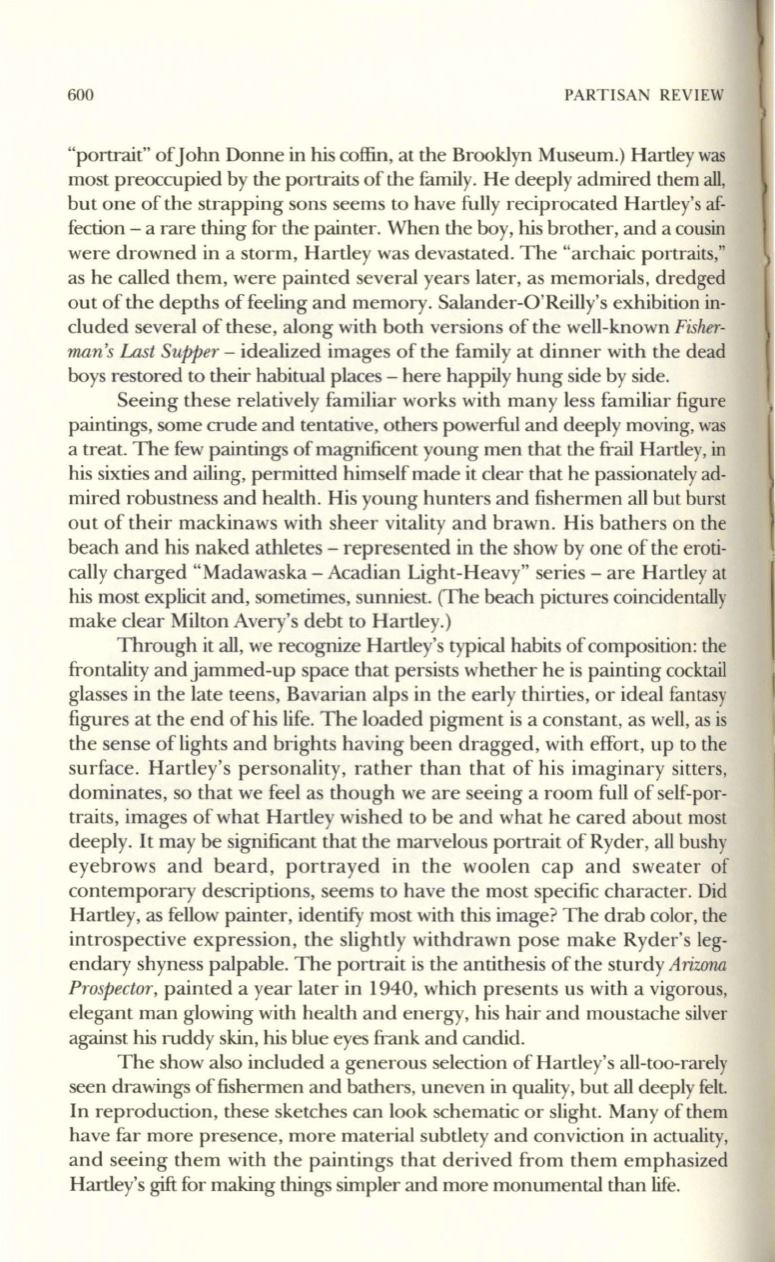
600
PARTISAN REVIEW
"portrait" ofJohn Donne in his coffin, at the Brooklyn Museum.) Hartley was
most preoccupied by the portraits of the family. He deeply admired them
all,
but one of the strapping sons seems to have fully reciprocated Hartley's
af–
fection - a rare thing for the painter. When the boy, his brother, and a cousin
were drowned in a storm, Hartley was devastated . The "archaic portraits,"
as he called them, were painted several years later, as memorials, dredged
out of the depths offeeling and memory. Salander-O'Reilly's exhibition in–
cluded several of these, along with both versions of the well-known
Fisher–
man's
Last
Supper
-
idealized images of the family at dinner with the dead
boys restored to their habitual places - here happily hung side by side.
Seeing these relatively familiar works with many less familiar figure
paintings, some crude and tentative, others powerful and deeply moving, was
a treat. The few paintings of magnificent young men that the frail Hartley, in
his sixties and ailing, permitted himself made it clear that he passionately ad–
mired robustness and health. His young hunters and fishermen all but burst
out of their mackinaws with sheer vitality and brawn. His bathers on the
beach and his naked athletes - represented in the show by one of the eroti–
cally charged "Madawaska - Acadian Light-Heavy" series - are Hartley at
his most explicit and, sometimes, sunniest. (fhe beach pictures coincidentally
make clear Milton Avery's debt to Hartley.)
Through it all, we recognize Hartley's typical habits ofcomposition: the
frontality and jammed-up space that persists whether he is painting cocktail
glasses in the late teens, Bavarian alps in the early thirties, or ideal fantasy
figures at the end of his life. The loaded pigment is a constant, as well, as is
the sense oflights and brights having been dragged, with effort, up to the
surface. Hartley's personality, rather than that of his imaginary sitters,
dominates, so that we feel as though we are seeing a room full of self-por–
traits, images of what Hartley wished to be and what he cared about most
deeply. It may be significant that the marvelous portrait of Ryder, all bushy
eyebrows and beard, portrayed in the woolen cap and sweater of
contemporary descriptions, seems to have the most specific character. Did
Hartley, as fellow painter, identify most with this image? The drab color, the
introspective expression, the slightly withdrawn pose make Ryder's leg–
endary shyness palpable. The portrait is the antithesis of the sturdy
Arizona
Prospector,
painted a year later in 1940, which presents us with a vigorous,
elegant man glowing with health and energy, his hair and moustache silver
against his ruddy skin, his blue eyes frank and candid.
The show also included a generous selection of Hartley's all-too-rarely
seen drawings of fishermen and bathers, uneven in quality, but all deeply felt.
In reproduction, these sketches can look schematic or slight. Many of them
have far more presence, more material subtlety and conviction in actuality,
and seeing them with the paintings that derived from them emphasized
Hartley's
gift
for making things simpler and more monumental than life.


